Question
The heights of apple trees in an orchard are normally distributed with a mean of \({\text{3.42 m}}\) and a standard deviation of \({\text{0.21 m}}\).
Write down the probability that a randomly chosen tree has a height greater than \({\text{3.42 m}}\).[1]
Write down the probability that a randomly chosen tree will be within 2 standard deviations of the mean of \({\text{3.42 m}}\).[1]
Use your graphic display calculator to calculate the probability that a randomly chosen tree will have a height greater than \({\text{3.35 m}}\).[2]
The probability that a particular tree is less than \(x\) metres high is \(0.65\). Find the value of \(x\).[2]
Answer/Explanation
Markscheme
\(0.5{\text{ }}\left( {50\% ,{\text{ }}\frac{{50}}{{100}},{\text{ }}\frac{1}{2}} \right)\) (A1) (C1)[1 mark]
\(0.954 (0.954499…, 95.4\%, 95.4499…\%)\) (A1) (C1)
Note: Accept \(95\%\) or \(0.95\).[1 mark]
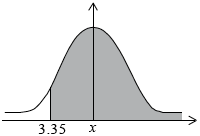 (M1)
(M1)
Note: Accept alternative methods.
\(0.631 (0.630558…, 63.1\%, 63.0558…\%)\) (A1) (C2)[2 marks]
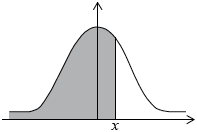 (M1)
(M1)
Note: Accept alternative methods.
\(3.50{\text{ }} (3.50091…)\) (A1) (C2)[2 marks]
Question
The daily January temperature of Cairns is normally distributed with a mean of 34°C and a standard deviation of 3.
Calculate the probability that the temperature on a randomly chosen day in January is less than 39°C.[2]
Calculate the expected number of days in January that the temperature will be more than 39°C.[2]
On a randomly chosen day in January, the probability that the temperature is above \(T\) °C is 0.7.
Find the value of \(T\).[2]
Answer/Explanation
Markscheme
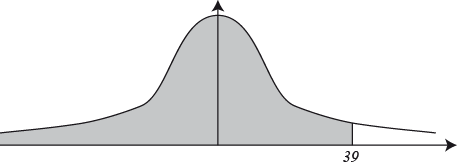 (M1)
(M1)
Note: Award (M1) for correctly shaded area.
\(0.952{\text{ }}(95.2\% ,{\text{ }}0.952209 \ldots )\) (A1) (C2)
\(31 \times (1 – 0.952209)\) (M1)
Note: Award (M1) for multiplying \(31\) by \(\left( {1 – {\text{ their answer to part (a)}}} \right)\).
\( = 1.48{\text{ }}(1.48150 \ldots )\) (A1)(ft) (C2)
Note: Follow through from part (a).
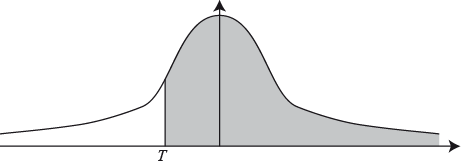 (M1)
(M1)
Note: Award (M1) for correctly shaded area.
\(32.4{\text{ }}(32.4267 \ldots )\) (A1) (C2)
Question
The weight, \(W\), of bags of rice follows a normal distribution with mean 1000 g and standard deviation 4 g.
Find the probability that a bag of rice chosen at random weighs between 990 g and 1004 g.[2]
95% of the bags of rice weigh less than \(k\) grams.
Find the value of \(k\).[2]
For a bag of rice chosen at random, \({\text{P}}(1000 – a < W < 1000 + a) = 0.9\).
Find the value of \(a\).[2]
Answer/Explanation
Markscheme
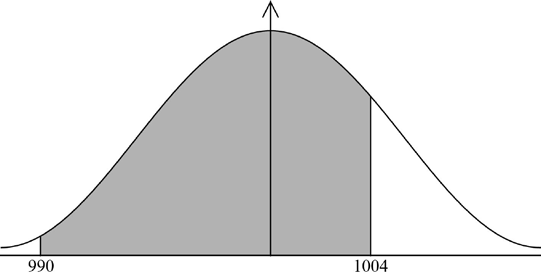 (M1)
(M1)
Note: Award (M1) for approximate curve with 990 and 1004 in correct place.
\(0.835\;\;\;(0.835135 \ldots ,{\text{ }}83.5\% )\) (A1) (C2)
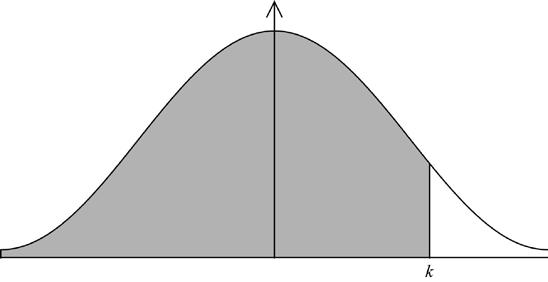 (M1)
(M1)
Note: Award (M1) for approximate curve with \(k\) placed to the right of the mean.
\(1010\;\;\;(1006.57 \ldots )\) (A1) (C2)
Note: Award full marks only for \(1010\), \(1007\) or an answer with more than \(4\) sf resulting from correct rounding of \(1006.57…\).
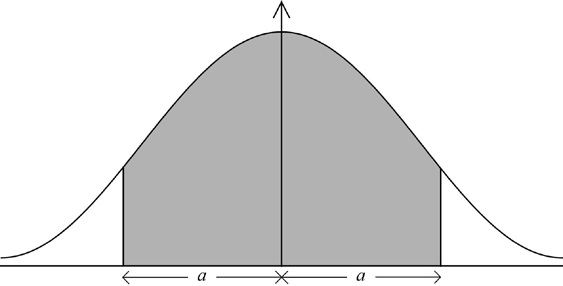 (M1)
(M1)
Note: Award (M1) for some indication of symmetry on diagram.
OR
\({\text{P}}(W < 1000 – a) = 0.05\;\;\;\)OR\(\;\;\;{\text{P}}(W > 1000 + a) = 0.05\) (M1)
Note: Award (M1) for probability with single inequality resulting from symmetry of diagram.
\((a = ){\text{ }}6.58\;\;\;(6.57941 \ldots )\) (A1) (C2)
Question
A factory makes metal bars. Their lengths are assumed to be normally distributed with a mean of 180 cm and a standard deviation of 5 cm.
On the following diagram, shade the region representing the probability that a metal bar, chosen at random, will have a length less than 175 cm.
 [2]
[2]
A metal bar is chosen at random.
(i) The probability that the length of the metal bar is less than 175 cm is equal to the probability that the length is greater than \(h\) cm. Write down the value of \(h\).
(ii) Find the probability that the length of the metal bar is greater than one standard deviation above the mean.[4]
Answer/Explanation
Markscheme
 (A1)(M1) (C2)
(A1)(M1) (C2)
Notes: Award (A1) for the vertical line labelled as \(175{\text{ (cm)}}\).
Award (M1) for a vertical line drawn to the left of the mean with the area to the left of this line shaded.
Accept \(( – )1\) sd marked on the diagram for \(175\) (provided line is to the left of the mean).
(i) \(185{\text{ (cm)}}\) (A1)(C1)
(ii) \({\text{P(length}} > 185)\) (A1)(M1)
Note: Award (A1) for the vertical line labelled as \(185{\text{ (cm)}}\).
Award (M1) for a vertical line drawn to the right of the mean with the area to the right of this line shaded.
Accept 1 sd marked on the diagram for \(185\) (provided line is to the right of the mean).
\( = 0.159\;\;\;(0.158655 \ldots )\) (A1) (C3)
Question
The lifetime, \(L\) , of light bulbs made by a company follows a normal distribution.
\(L\) is measured in hours. The normal distribution curve of \(L\) is shown below.
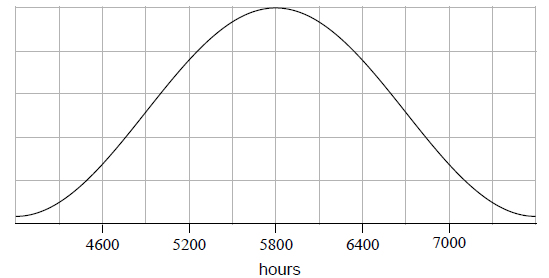
Write down the mean lifetime of the light bulbs.[1]
The standard deviation of the lifetime of the light bulbs is \(850\) hours.
Find the probability that \(5000 \leqslant L \leqslant 6000\) , for a randomly chosen light bulb.[2]
The company states that \(90\% \) of the light bulbs have a lifetime of at least \(k\) hours.
Find the value of \(k\) . Give your answer correct to the nearest hundred.[3]
Answer/Explanation
Markscheme
\(5800\) (A1) (C1)
\(0.420\,\,\,(0.419703…)\) (A2)(ft) (C2)
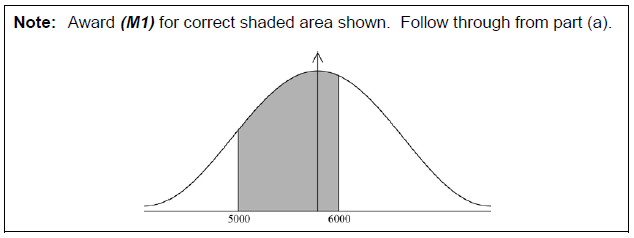
\(4710.68…\) (A2)(ft)
\( = 4700\) (A1)(ft) (C3)
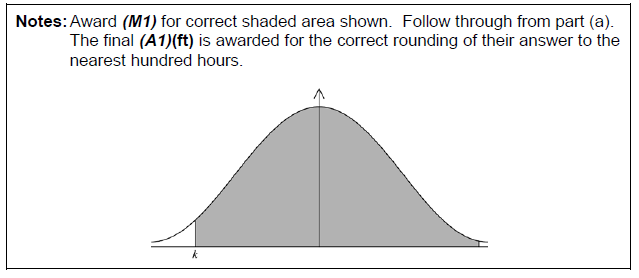
Question
The mass of a certain type of Chilean corncob follows a normal distribution with a mean of 400 grams and a standard deviation of 50 grams.
A farmer labels one of these corncobs as premium if its mass is greater than \(a\) grams. 25% of these corncobs are labelled as premium.
Write down the probability that the mass of one of these corncobs is greater than 400 grams.[1]
Find the value of \(a\).[2]
Estimate the interquartile range of the distribution.[3]
Answer/Explanation
Markscheme
\(0.5{\text{ }}\left( {50\% ,{\text{ }}\frac{1}{2}} \right)\) (A1) (C1)[1 mark]
\({\text{P}}(X > a) = 0.25\)\(\,\,\,\)OR\(\,\,\,\)\({\text{P}}(X < a) = 0.75\) (M1)
Note: Award (M1) for a sketch of approximate normal curve with a vertical line drawn to the right of the mean with the area to the right of this line shaded.
\(a = 434{\text{ (g) }}\left( {433.724 \ldots {\text{ (g)}}} \right)\) (A1) (C2)[2 marks]
\(33.7244 \ldots \times 2\) (A1)(ft)(M1)
Note: Award (A1)(ft) for \(33.7244 \ldots {\text{ }}({\text{or }}433.7244 \ldots {\text{ }} – {\text{ }}400)\) seen, award (M1) for multiplying their 33.7244… by 2. Follow through from their answer to part (b).
OR
\(434 – 366.275 \ldots \) (A1)(ft)(M1)
Note: Award (A1)(ft) for their \(366.275 \ldots {\text{ }}(366)\) seen, (M1) for difference between their answer to (b) and their 366.
OR
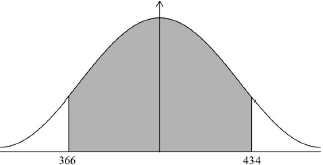 (A1)(ft)(M1)
(A1)(ft)(M1)
Note: Award (A1)(ft) for their \(366.275 \ldots {\text{ }}(366)\) seen. Award (M1) for correct symmetrical region indicated on labelled normal curve.
67.4 (g) (A1)(ft) (C3)
Note: Accept an answer of 68 from use of rounded values. Follow through from part (b).[3 marks]
Question
Applicants for a job had to complete a mathematics test. The time they took to complete the test is normally distributed with a mean of 53 minutes and a standard deviation of 16.3. One of the applicants is chosen at random.
For 11% of the applicants it took longer than \(k\) minutes to complete the test.
There were 400 applicants for the job.
Find the probability that this applicant took at least 40 minutes to complete the test.[2]
Find the value of \(k\).[2]
Estimate the number of applicants who completed the test in less than 25 minutes.[2]
Answer/Explanation
Markscheme
0.787 (0.787433…, 78.7%) (M1)(A1) (C2)
Note: Award (M1) for a correct probability statement, \({\text{P}}(X > 40)\), or a correctly shaded normal distribution graph.
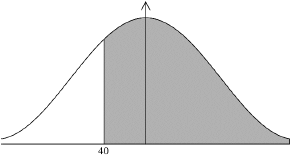 [2 marks]
[2 marks]
73.0 (minutes) (72.9924…) (M1)(A1) (C2)
Note: Award (M1) for a correct probability statement, \({\text{P}}(X > k) = 0.11\), or a correctly shaded normal distribution graph.
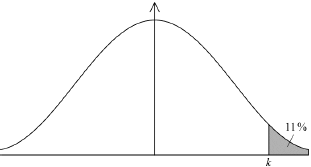 [2 marks]
[2 marks]
\(0.0423433 \ldots \times 400\) (M1)
Note: Award (M1) for multiplying a probability by 400. Do not award (M1) for \(0.11 \times 400\).
Use of a lower bound less than zero gives a probability of 0.0429172….
\( = 16\) (A1) (C2)
Notes: Accept a final answer of 17. Do not accept a final answer of 18. Accept a non-integer final answer either 16.9 (16.9373…) from use of lower bound zero or 17.2 (17.1669…) from use of the default lower bound of \(-{10^{99}}\).[2 marks]
Question
Malthouse school opens at 08:00 every morning.
The daily arrival times of the 500 students at Malthouse school follow a normal distribution. The mean arrival time is 52 minutes after the school opens and the standard deviation is 5 minutes.
Find the probability that a student, chosen at random arrives at least 60 minutes after the school opens.[2]
Find the probability that a student, chosen at random arrives between 45 minutes and 55 minutes after the school opens.[2]
A second school, Mulberry Park, also opens at 08:00 every morning. The arrival times of the students at this school follows exactly the same distribution as Malthouse school.
Given that, on one morning, 15 students arrive at least 60 minutes after the school opens, estimate the number of students at Mulberry Park school.[2]
Answer/Explanation
Markscheme
0.0548 (0.054799…, 5.48%) (A2) (C2)
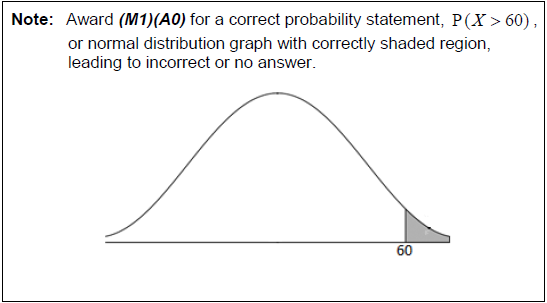 [2 marks]
[2 marks]
0.645 (0.6449900…, 64.5%) (A2) (C2)
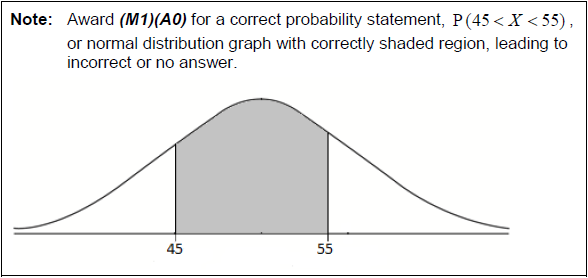 [2 marks]
[2 marks]
\(\frac{{15}}{{0.0548}}\) (M1)
Note: Award (M1) for dividing 15 by their part (a)(i).
Accept an equation of the form 15 = x × 0.0548 for (M1).
274 (273.722…) (A1)(ft) (C2)
Note: Follow through from part (a)(i). Accept 273.[2 marks]

